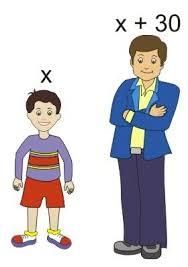Expressions, Formulae, and Equations | Year 8 Mathematics IGCSE (Cambridge) - Class 8 PDF Download
| Table of contents |

|
| Constructing Expressions |

|
| Using Expressions and Formulae |

|
| Expanding Brackets |

|
| Factorising |

|
Constructing Expressions
What is an Expression?
An expression is a combination of numbers, variables, and mathematical operations (such as addition, subtraction, multiplication, and division). For example, 3x + 5 and 2y − 7 are expressions.
How to Construct Expressions
To construct an expression, follow these steps:
- Identify the variables: These are the symbols that represent unknown values (e.g., x or y).
- Choose the constants: These are the fixed numbers that do not change (e.g., 3, 5, 7).
- Combine with operations: Use addition, subtraction, multiplication, or division to combine variables and constants.
Example:
- Problem: John has x apples, and he buys 5 more. How can we represent the total number of apples?
- Expression: x + 5

Using Expressions and Formulae
What is a Formula?
A formula is a mathematical rule expressed using symbols. It shows the relationship between different variables. For example, the formula for the area of a rectangle is A = l × w, where A is the area, l is the length, and w is the width.
How to Use Expressions in Formulae
To use expressions in formulae, substitute the values of variables into the expression and then perform the calculations.
Example:
Problem: The formula for the perimeter of a rectangle is P = 2l + 2w. If the length l = 4 and the width w = 3, find the perimeter.
Solution: Substitute l = 4 and w = 3 into the formula:
P = 2(4) + 2(3)
Calculate: P = 8 + 6 = 14
Expanding Brackets
What is Expanding Brackets?
Expanding brackets means to multiply out the terms inside the brackets. For example, to expand 3(x + 4), multiply 3 by both x and 4.
How to Expand Brackets
- Distribute the term outside the brackets: Multiply it by each term inside the brackets.
- Simplify the expression: Combine like terms if necessary.
Example:
Problem: Expand 2(x + 5).
Solution: Distribute 2 to both x and 5:
2 ⋅ x + 2⋅5
Simplify: 2x + 10
Factorising
What is Factorising?
Factorising is the reverse process of expanding. It involves writing an expression as a product of its factors.
How to Factorise
- Find the common factor: Identify the greatest common factor of the terms.
- Rewrite the expression: Express the terms as a product of the common factor and the remaining terms inside brackets.
Example:
Problem: Factorise 4x + 8.
Solution: Identify the common factor (4):
4(x + 2)
Factorising Quadratic Expressions
To factorise quadratic expressions like ax2 + bx + c, look for two numbers that multiply to ac and add to b.
Example:
Problem: Factorise x2 + 5x + 6.
Solution: Find two numbers that multiply to 6 and add to 5 (2 and 3): (x + 2)(x + 3)
|
42 videos|62 docs|24 tests
|
FAQs on Expressions, Formulae, and Equations - Year 8 Mathematics IGCSE (Cambridge) - Class 8
| 1. What is the difference between an expression, a formula, and an equation? |  |
| 2. How are expressions used in mathematics? |  |
| 3. Can a formula be an equation? |  |
| 4. How do you solve an equation with multiple variables? |  |
| 5. What is the importance of understanding expressions and formulas in mathematics? |  |














